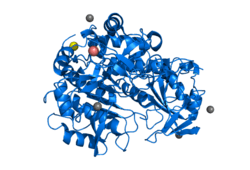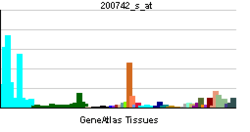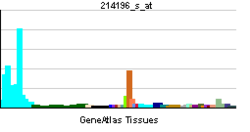Tripeptidyl peptidase I
| View/Edit Human | View/Edit Mouse |
Tripeptidyl-peptidase 1, also known as Lysosomal pepstatin-insensitive protease, is an enzyme that in humans is encoded by the TPP1 gene.[3][4] TPP1 mainly functions as a regulator of telomerase recruitment, activation, and regulation.[5] Mutations in the TPP1 gene leads to late infantile neuronal ceroid lipofuscinosis.[6]
Structure
Gene
The human gene TPP1 encodes a member of the sedolisin family of serine proteases. The human gene has 13 exons and locates at the chromosome band 11p15.[4]
Protein
The human TPP1 is 61kDa in size and composed of 563 amino acids. An isoform of 34.5kDa and 320 amino acids is generated by alternative splicing and a peptide fragment of 1-243 amino acid is missing.[7] TPP1 contains a globular structure with a subtilisin-like fold, a Ser475-Glu272-Asp360 catalytic triad. It also contains an octahedrally coordinated Ca2+-binding site that are characteristic features of the S53 sedolisin family of peptidases. Unlike other S53 peptidases, it has steric constraints on the P4 substrate pocket, which might contribute to its preferential cleavage of tripeptides from the unsubstituted N-terminus of proteins. Two alternative conformations of the catalytic Asp276 are associated with the activation status of TPP1.[8]
Function
High expression of TPP1 is found in bone marrow, placenta, lung, pineal and lymphocytes. The protease functions in the lysosome to cleave N-terminal tripeptides from substrates and has weaker endopeptidase activity. It is synthesized as a catalytically inactive enzyme which is activated and autoproteolyzed upon acidification. TPP1 is a component of the telomere-specific shelterin complex, which facilitats the replication of the double-stranded telomeric DNA tracts and protects the telomeric end from unregulated DNA repair activities. TPP1 mainly functions as a regulator of telomerase recruitment, activation, and regulation.[5] Although TPP1 was originally described as a bridging factor between TRF1 and TRF2, which participate in a pathway with POT1 as a negative regulator of telomerase-dependent telomere length control, [9] more recent studies suggest that TPP1 could directly promotes telomerase activity at the telomere.[10] A part of the TPP1 oligonucleotide/oligosaccharide-binding (OB) fold named TEL patch that interacts with the catalytic subunit of telomerase, hTERT, has been proven essential for telomerase activation.[11] What’s more, TPP1 has been demonstrated the only pathway required for recruitment of telomerase to chromosome ends, and it also defines telomere length homeostasis in hESCs.[11]
Clinical significance
The neuronal ceroid lipofuscinoses (NCLs) are a group of inherited neurodegenerative disorders with pathological phenotypes that auto fluorescent lipopigments present in neurons and other cell types. Over the past two decades, accumulating evidences indicates that NCLs are caused by mutations in eight different genes, including genes encoding several soluble proteins (cathepsin D, PPT1, and TPP1).[12] Mutations of gene TPP1 result in late-infantile neuronal ceroid lipofuscinosis which is associated with the failure to degrade specific neuropeptides and a subunit of ATP synthase in the lysosome.[13] Mutations in the TPP1 gene lead to late infantile neuronal ceroid lipofuscinosis, a fatal neurodegenerative disease of childhood.[8] It has been demonstrated that a single injection of intravitreal implantation of autologous bone marrow derived stem cells transduced with a TPP1 expression construct at an early stage in the disease progression could substantially inhibite the development of disease-related retinal function deficits and structural changes. This result implies that ex vivo gene therapy using autologous stem cells may be an effective means of achieving sustained delivery of therapeutic compounds to tissues such as the retina for which systemic administration would be ineffective.[14]
Interaction
References
- ↑ "Human PubMed Reference:".
- ↑ "Mouse PubMed Reference:".
- ↑ Liu CG, Sleat DE, Donnelly RJ, Lobel P (June 1998). "Structural organization and sequence of CLN2, the defective gene in classical late infantile neuronal ceroid lipofuscinosis". Genomics. 50 (2): 206–12. doi:10.1006/geno.1998.5328. PMID 9653647.
- 1 2 "Entrez Gene: TPP1 tripeptidyl peptidase I".
- 1 2 Karlseder J (September 2014). "Modern genome editing meets telomeres: the many functions of TPP1". Genes & Development. 28 (17): 1857–8. doi:10.1101/gad.250316.114. PMID 25184673.
- ↑ Bukina AM, Tsvetkova IV, Semiachkina AN, Il'ina ES (Nov 2002). "[Tripeptidyl peptidase 1 deficiency in neuronal ceroid lipofuscinosis. A novel mutation]". Voprosy Medit︠s︡inskoĭ Khimii. 48 (6): 594–8. PMID 12698559.
- ↑ "Uniprot: O14773 - TPP1_HUMAN".
- 1 2 Pal A, Kraetzner R, Gruene T, Grapp M, Schreiber K, Grønborg M, Urlaub H, Becker S, Asif AR, Gärtner J, Sheldrick GM, Steinfeld R (February 2009). "Structure of tripeptidyl-peptidase I provides insight into the molecular basis of late infantile neuronal ceroid lipofuscinosis". The Journal of Biological Chemistry. 284 (6): 3976–84. doi:10.1074/jbc.M806947200. PMID 19038966.
- 1 2 Hockemeyer D, Palm W, Else T, Daniels JP, Takai KK, Ye JZ, Keegan CE, de Lange T, Hammer GD (August 2007). "Telomere protection by mammalian Pot1 requires interaction with Tpp1". Nature Structural & Molecular Biology. 14 (8): 754–61. doi:10.1038/nsmb1270. PMID 17632522.
- 1 2 Nandakumar J, Bell CF, Weidenfeld I, Zaug AJ, Leinwand LA, Cech TR (December 2012). "The TEL patch of telomere protein TPP1 mediates telomerase recruitment and processivity". Nature. 492 (7428): 285–9. doi:10.1038/nature11648. PMID 23103865.
- 1 2 Sexton AN, Regalado SG, Lai CS, Cost GJ, O'Neil CM, Urnov FD, Gregory PD, Jaenisch R, Collins K, Hockemeyer D (September 2014). "Genetic and molecular identification of three human TPP1 functions in telomerase action: recruitment, activation, and homeostasis set point regulation". Genes & Development. 28 (17): 1885–99. doi:10.1101/gad.246819.114. PMID 25128433.
- ↑ Getty AL, Pearce DA (February 2011). "Interactions of the proteins of neuronal ceroid lipofuscinosis: clues to function". Cellular and Molecular Life Sciences. 68 (3): 453–74. doi:10.1007/s00018-010-0468-6. PMID 20680390.
- ↑ Gardiner RM (2000). "The molecular genetic basis of the neuronal ceroid lipofuscinoses". Neurological Sciences. 21 (3 Suppl): S15–9. PMID 11073223.
- ↑ Tracy CJ, Whiting RE, Pearce JW, Williamson BG, Vansteenkiste DP, Gillespie LE, Castaner LJ, Bryan JN, Coates JR, Jensen CA, Katz ML (September 2016). "Intravitreal implantation of TPP1-transduced stem cells delays retinal degeneration in canine CLN2 neuronal ceroid lipofuscinosis". Experimental Eye Research. 152: 77–87. doi:10.1016/j.exer.2016.09.003. PMID 27637672.
- ↑ Takai KK, Hooper S, Blackwood S, Gandhi R, de Lange T (January 2010). "In vivo stoichiometry of shelterin components". The Journal of Biological Chemistry. 285 (2): 1457–67. doi:10.1074/jbc.M109.038026. PMID 19864690.
- 1 2 3 O'Connor MS, Safari A, Xin H, Liu D, Songyang Z (August 2006). "A critical role for TPP1 and TIN2 interaction in high-order telomeric complex assembly". Proceedings of the National Academy of Sciences of the United States of America. 103 (32): 11874–9. doi:10.1073/pnas.0605303103. PMID 16880378.
- ↑ Zaug AJ, Podell ER, Nandakumar J, Cech TR (March 2010). "Functional interaction between telomere protein TPP1 and telomerase". Genes & Development. 24 (6): 613–22. doi:10.1101/gad.1881810. PMID 20231318.
Further reading
- Mole SE, Mitchison HM, Munroe PB (1999). "Molecular basis of the neuronal ceroid lipofuscinoses: mutations in CLN1, CLN2, CLN3, and CLN5". Human Mutation. 14 (3): 199–215. doi:10.1002/(SICI)1098-1004(1999)14:3<199::AID-HUMU3>3.0.CO;2-A. PMID 10477428.
- Dawson G, Cho S (April 2000). "Batten's disease: clues to neuronal protein catabolism in lysosomes". Journal of Neuroscience Research. 60 (2): 133–40. doi:10.1002/(SICI)1097-4547(20000415)60:2<133::AID-JNR1>3.0.CO;2-3. PMID 10740217.
- Hofmann SL, Atashband A, Cho SK, Das AK, Gupta P, Lu JY (August 2002). "Neuronal ceroid lipofuscinoses caused by defects in soluble lysosomal enzymes (CLN1 and CLN2)". Current Molecular Medicine. 2 (5): 423–37. doi:10.2174/1566524023362294. PMID 12125808.
- Maruyama K, Sugano S (January 1994). "Oligo-capping: a simple method to replace the cap structure of eukaryotic mRNAs with oligoribonucleotides". Gene. 138 (1-2): 171–4. doi:10.1016/0378-1119(94)90802-8. PMID 8125298.
- Page AE, Fuller K, Chambers TJ, Warburton MJ (November 1993). "Purification and characterization of a tripeptidyl peptidase I from human osteoclastomas: evidence for its role in bone resorption". Archives of Biochemistry and Biophysics. 306 (2): 354–9. doi:10.1006/abbi.1993.1523. PMID 8215436.
- Sleat DE, Donnelly RJ, Lackland H, Liu CG, Sohar I, Pullarkat RK, Lobel P (September 1997). "Association of mutations in a lysosomal protein with classical late-infantile neuronal ceroid lipofuscinosis". Science. 277 (5333): 1802–5. doi:10.1126/science.277.5333.1802. PMID 9295267.
- Suzuki Y, Yoshitomo-Nakagawa K, Maruyama K, Suyama A, Sugano S (October 1997). "Construction and characterization of a full length-enriched and a 5'-end-enriched cDNA library". Gene. 200 (1-2): 149–56. doi:10.1016/S0378-1119(97)00411-3. PMID 9373149.
- Rawlings ND, Barrett AJ (January 1999). "Tripeptidyl-peptidase I is apparently the CLN2 protein absent in classical late-infantile neuronal ceroid lipofuscinosis". Biochimica et Biophysica Acta. 1429 (2): 496–500. doi:10.1016/S0167-4838(98)00238-6. PMID 9989235.
- Vines DJ, Warburton MJ (January 1999). "Classical late infantile neuronal ceroid lipofuscinosis fibroblasts are deficient in lysosomal tripeptidyl peptidase I". FEBS Letters. 443 (2): 131–5. doi:10.1016/S0014-5793(98)01683-4. PMID 9989590.
- Sleat DE, Gin RM, Sohar I, Wisniewski K, Sklower-Brooks S, Pullarkat RK, Palmer DN, Lerner TJ, Boustany RM, Uldall P, Siakotos AN, Donnelly RJ, Lobel P (June 1999). "Mutational analysis of the defective protease in classic late-infantile neuronal ceroid lipofuscinosis, a neurodegenerative lysosomal storage disorder". American Journal of Human Genetics. 64 (6): 1511–23. doi:10.1086/302427. PMC 1377895
 . PMID 10330339.
. PMID 10330339. - Junaid MA, Wu G, Pullarkat RK (January 2000). "Purification and characterization of bovine brain lysosomal pepstatin-insensitive proteinase, the gene product deficient in the human late-infantile neuronal ceroid lipofuscinosis". Journal of Neurochemistry. 74 (1): 287–94. doi:10.1046/j.1471-4159.2000.0740287.x. PMID 10617131.
- Ezaki J, Takeda-Ezaki M, Oda K, Kominami E (February 2000). "Characterization of endopeptidase activity of tripeptidyl peptidase-I/CLN2 protein which is deficient in classical late infantile neuronal ceroid lipofuscinosis". Biochemical and Biophysical Research Communications. 268 (3): 904–8. doi:10.1006/bbrc.2000.2207. PMID 10679303.
- Haines JL, Boustany RM, Alroy J, Auger KJ, Shook KS, Terwedow H, Lerner TJ (March 1998). "Chromosomal localization of two genes underlying late-infantile neuronal ceroid lipofuscinosis". Neurogenetics. 1 (3): 217–22. doi:10.1007/s100480050032. PMID 10737126.
- Ezaki J, Takeda-Ezaki M, Kominami E (September 2000). "Tripeptidyl peptidase I, the late infantile neuronal ceroid lipofuscinosis gene product, initiates the lysosomal degradation of subunit c of ATP synthase". Journal of Biochemistry. 128 (3): 509–16. doi:10.1093/oxfordjournals.jbchem.a022781. PMID 10965052.
- Lin L, Sohar I, Lackland H, Lobel P (January 2001). "The human CLN2 protein/tripeptidyl-peptidase I is a serine protease that autoactivates at acidic pH". The Journal of Biological Chemistry. 276 (3): 2249–55. doi:10.1074/jbc.M008562200. PMID 11054422.
- Lam CW, Poon PM, Tong SF, Ko CH (March 2001). "Two novel CLN2 gene mutations in a Chinese patient with classical late-infantile neuronal ceroid lipofuscinosis". American Journal of Medical Genetics. 99 (2): 161–3. doi:10.1002/1096-8628(2001)9999:9999<::AID-AJMG1145>3.0.CO;2-Z. PMID 11241479.
- Zhong N, Moroziewicz DN, Ju W, Jurkiewicz A, Johnston L, Wisniewski KE, Brown WT (2001). "Heterogeneity of late-infantile neuronal ceroid lipofuscinosis". Genetics in Medicine. 2 (6): 312–8. doi:10.1097/00125817-200011000-00002. PMID 11339651.
External links
- The MEROPS online database for peptidases and their inhibitors: S53.003
- GeneReviews/NCBI/NIH/UW entry on Neuronal Ceroid-Lipofuscinoses



